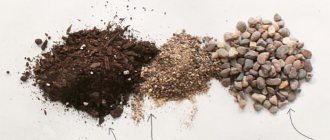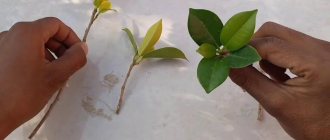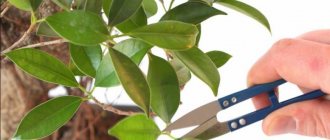Features of Ficus Benjamin
Ficus Benjamin
In confined and enclosed apartment conditions, the Ficus Benjamin, attributed to the Mulberry family, rarely extends above two meters. However, in the wild, this shrub or tree-like crop can outgrow 25-30 meters.
Ficus domestica most often looks like a not too large, short-trunked tree with a dense and extremely branched crown. The leaf blades are short-petioled, smooth-leathery, shiny, elongated and oval in shape. With a clearly visible central vein and a very sharp narrow tip. The size (6-13 cm - length, 2-6 cm - width), as well as the color of ficus leaves, are very diverse and are determined by the specific variety.
The trunk and erect, rapidly woody shoots are covered with smooth grayish-brownish bark, speckled with rare darker streaks.
The root system is powerful and strong, equally well developed both in depth and in width. In cultivation, Ficus Benjamina does not bloom and does not produce fruit. It is valued by flower growers and florists and landscapers precisely for its attractive ground green part.
In its natural tropical environment, ficus produces small (up to 2 cm) orange or reddish inedible fruits.
Crown formation, ficus pruning
Pruning is a popular method that allows you to give your ficus benjamina the desired shape. Most often, the following types of crown formation are used for these plants:
- Ball-shaped crown.
- Bush-like.
- In the form of a single or multi-tiered standard.
- Bonsai style.
- In the form of various sculptures.
Experts recommend planning to trim your ficus in spring or early summer, since it is at this time of year that its accelerated growth begins.
When forming the crown, it is necessary to take into account the age of the plant. It is easiest to give the desired crown shape to young specimens. This, in turn, guarantees that as a result of pruning the plant will acquire the required shape.
Pruning Ficus Benjamin is usually considered in relation to those plants that have a fairly overgrown crown, or specimens that, due to their unusually large size, have lost their former attractiveness.
In order to avoid unpleasant consequences after pruning ficus Benjamin, it is necessary to carry out this operation taking into account the following rules:
- try to ensure that after the operation the plant does not lose its naturalness;
- before removing the branches, try to imagine what the ficus will look like without them;
- branches must be removed only with a sterile instrument;
- it is necessary to keep the bark intact;
- When pruning ficus, you must ensure that the leaves are not damaged;
- Ficus branches must be removed at an angle to the top edge.
How to braid ficus trunks
Crown formation is not the only method that allows you to return the plant to its former attractiveness. Another method is to weave tables.
To do this, you will have to select a couple of young specimens that have a similar thickness and table height, which are subsequently transplanted into a common pot.
Since the trunks of such plants become semi-lignified and at the same time retain their flexibility, they can be woven without difficulty. Where the side shoots join, be sure to cut off all the leaves.
When creating a spiral and braid, you need to leave a lot of space, counting on the subsequent thickening of the trunks. A favorable time for the beginning of interlacing of trunks occurs when the lower part of the flower grows to 13 cm.
Ficus benjamina is one of the brightest representatives of the ficus family, which has retained all the best qualities of this indoor plant.
Growing it at home is a fairly simple undertaking, however, it also has its own issues regarding care.
First of all, you need to pay attention to the fact that the plant must be periodically replanted into a new container.
If it is important for the owner to maintain the decorative properties of ficus Benjamin, then he will have to regularly trim the branches
When should you replant?
Ficus Benjamin: replanting is already required
The most favorable time of year when it is recommended to replant any indoor evergreen perennials and Ficus Benjamin, including the very end of winter or early spring. Throughout the entire cold period, vegetative processes are significantly inhibited and plants remain in relative peace. It is better to replant them before growth begins.
Rapidly developing young ficus trees (up to 4 years old) must be provided with new housing every year, since they master the living space very quickly after transplantation. Older Benjamins need this much less often - they need larger pots about once every 2-3 years. Large and older specimens (from 7 years old) are not touched at all, but only replace the depleted upper substrate layer in the container with the ficus with a fresh one.
It is permissible to replant the plant throughout the spring and summer months and even in early autumn. The main thing is that it has time to acclimatize after transplantation and take root in the new place before the cold weather arrives (then daylight hours are shortened). In winter, ficus is disturbed only in the most serious and exceptional cases, when it is clear that it is not able to survive until spring.
There may be several reasons prompting a florist to carry out transplant work with Benjamin:
- the flower has completely entwined the substrate lump (in this case, the roots can crawl out through the drainage holes) and the current pot has become too small for it;
- the soil mixture in the planting container is depleted or salted;
- the plant stopped growing, young leaves on the ficus stopped appearing;
- the clod of earth has dried out, when watering, water immediately flows into the pan;
- there are signs of malaise or disease of Ficus Benjamin (the soil has become sour, moldy, etc.) or the activity of pests (nematodes, flies, etc.) in the root system - in this case, an urgent transplant will be required;
- the flower was recently purchased and brought into the house.
Is a transplant necessary after purchase?
Ficus benjamina: replanting after purchase
No flower will be able to develop normally and fully in store-bought transport soil, which is where the purchased plants are located. In addition, when kept in greenhouse and store conditions, excessive amounts of all kinds of fertilizers, as well as substances that stimulate their rapid growth, are often used to maintain the vital activity of plant crops. Having completely exhausted all these additives, the indoor tree begins to suffer from a lack of nutrients.
Ficus Benjamin will definitely need to be replanted with a replacement of the substrate soil mixture after purchase. But you can’t do this right away; you need to let the newcomer get used to the place and other conditions of detention. For high-quality acclimatization, 15-20 days are usually enough. Only after this can a transplant be done.
Choosing a pot
When replanting a ficus Benjamin, the pot is selected with a slightly larger diameter.
When purchasing a ficus Benjamin, experienced lovers of indoor flowers are advised to immediately decide what kind of pot it needs when replanting. The material of manufacture is not at all important, since these tropical plants feel equally good in both wooden tubs and plastic cups. However, most often when transplanting ficus trees, the choice is made between clay (ceramics) and plastic.
Clay vessels are more stable because they are heavy. But their porous walls quickly become clogged with mineral deposits, becoming covered with an unsightly and difficult-to-remove coating. And ceramic products are quite expensive. Plastic pots are cheap and come in a wide range of colors and shapes. After replanting, you will need to water the plants less often, because plastic retains moisture better. However, access to fresh air to the roots of Benjamin will be difficult, so any overwatering is fraught with acidification of the soil and subsequent rotting of the root system.
Decisive importance is attached to the volume of the new ficus container, which should not be too large. In a very spacious pot, after transplantation, the flower will grow at a slow pace until its roots have mastered the entire internal volume. It is enough to choose a container whose diameter and height will be only 2-3 cm higher than the similar parameters of the previous pot. As a standard, for replanting Benjamin, a pot with approximately equal dimensions in height and width is selected.
Before replanting the ficus, the planting container must be thoroughly washed with soap and then disinfected with a solution of potassium permanganate (15-20 minutes). Ceramic and clay pots can be doused with boiling water before replanting (only on the inside).
Preparatory work before transplantation
Preparatory work for transplanting a ficus begins in advance and consists of selecting a planting container and preparing a nutrient substrate.
Choosing a pot
For the plant, select a plastic or clay vessel 2-3 cm (both in width and height) larger than the one in which it was located when purchased. A “growing” pot will provide the ficus with more soil and allow it to freely grow its root system.
Both options have a right to exist. The disadvantage of a plastic vessel can be considered to be its unpresentable appearance, while the disadvantage of a ceramic vessel is rapid hypothermia on a winter windowsill. Both problems can be solved: an unsightly plastic pot can be placed in a beautiful glass flowerpot, and insulating material can be placed under the bottom of the clay pot for the winter. Be it an ordinary board or a piece of foam.
Currently, flower growers have the opportunity to acquire flower pots equipped with automatic watering.
Flower pot with automatic watering
This innovation is convenient because there is no need to constantly check the soil moisture. “Smart” pots are equipped with an indicator that shows the water level at the bottom of the tank and the gardener only has to add water when the float drops to a minimum.
The first drawback, so to speak, can be considered the fact that the system works when the earthen coma is completely entwined with roots, because Plants independently regulate water consumption and supply. If a plant with a small root system was planted in such a pot, it will take 2-3 months for it to grow. All this time, the flower must be watered using traditional methods.
The second disadvantage is the rather high price compared to plastic.
The planting container is thoroughly washed with soapy water or disinfected with a solution of potassium permanganate.
Soil preparation
Prepare the soil mixture in advance, adding leaf humus, peat and sand in equal proportions. The pH level for ficus should be within 5.5-6.5 units, i.e. be neutral or slightly acidic, and also have high moisture and breathability.
Before filling the planting container, the composition is disinfected using potassium permanganate or boiling water. This will destroy possible pathogens. Additionally, they are treated with the drug “Fitosporin”, which will serve as prevention against parasitic microorganisms.
A small addition of expanded clay or vermiculite is allowed to improve the drainage properties of the soil mixture. This composition is most applicable when transplanting young plants.
For adult specimens, leaf humus can be replaced with garden soil, and the remaining components can be left the same, maintaining the same ratios. This is explained by the fact that the root system of young plants develops better on light soils, while for an adult specimen it is preferable to choose dense soil.
Soil preparation
In almost every large supermarket or florist shopping center you can find specialized soil designed specifically for ficus plants. If this is not possible, then it is quite possible to prepare an earthen mixture for Benjamin yourself, using (2:1:2:1):
- turf;
- peat (preferably lowland);
- leaf soil;
- coarse-grained river sand with small pebbles (pre-sifted and washed).
It is advisable to add about 10% more crushed carbon (activated or charcoal). For young Benjamin, it is better to take a looser mixture of humus (preferably leaf or pine), sand and peat (1:1:1).
The mixed composition for ficus must be disinfected before transplantation in one of the following ways:
- spilling a strong solution (dark red) of potassium permanganate;
- steamed;
- calcined at maximum in a microwave oven or oven;
- treated with Fitosporin;
- keeping it in the cold (can be in the freezer).
Ficus benjamina loves soil with neutral acidity (5.5-6.5 pH); in an acidic environment this culture does not develop well.
Reproduction
Theoretically, the plant can be propagated in different ways: both vegetatively and using seeds. In practice, all types and varieties of Ficus Benjamin are propagated by cuttings, which remain in abundance after spring pruning of the plant. Although cuttings can be cut and rooted all year round, in spring the speed of shoot growth is maximum, and they take root better.
Do it this way. Using a clean tool (knife or pruning shears), cut off the apical shoot from the ficus, at least 10 - 12 cm long. Do not touch the upper leaves, you only need to remove a couple of lower ones, near the cut. When cut, the cutting will secrete droplets of milky juice - they should be blotted with a sterile napkin or rinsed under running water until it stops secreting. If the sap is allowed to harden, it will prevent root formation. Then air dry the cut. Now you can put the cuttings to root in water or directly in the substrate. Let's consider both options.
Rooting in water
Note that in the spring, ficus cuttings form roots more readily than at other times of the year, even in plain water. The procedure here is as follows:
- Place the prepared cuttings in a glass (preferably opaque) with water. The water should be settled, at room temperature, no more than half a glass, so that the lower leaves do not touch the water.
- It is advisable to add half a tablet of aspirin and activated carbon to the water to ensure that the shoot does not rot. If desired, you can add a few drops of some drug that stimulates root formation to the water, for example, Kornevin.
- Place the container with the cutting in a warm place (about 25 degrees), illuminated by the scattered rays of the sun. The water will evaporate - do not forget to add it to the previous level. In two to four weeks, roots should appear.
- When the roots grow a little, transplant the cuttings into a pot with suitable soil, cover it with a bag or jar to create a greenhouse effect with high humidity.
- From time to time, open the greenhouse slightly for ventilation and to accustom the young plant to the temperature of the apartment.
- A guarantee of successful rooting will be the appearance in a week or two of a new sprout next to the transplanted cuttings. Then the cover can be removed and the pot can be moved to the place chosen for it.
This may be interesting: Tillandsia epiphytes: atmospheric, usniform and others
Rooting in the substrate
It is believed that the bush obtained in this way grows and develops faster. It is important here that the composition of the substrate is most suitable for Ficus Benjamin: fertile, breathable, with neutral acidity.
- Place the cutting in a small pot with drainage and substrate in the center.
- Pour in settled water with the addition of Kornevin or other similar preparations, for example, Gileya.
- Cover the glass with film or another glass on top to create a mini greenhouse.
- Place this greenhouse in a warm place with indirect light for three to five weeks. During this time, roots should appear on the cuttings.
- The cover can be removed. As soon as the sprout begins to grow, we can assume that rooting has been successful.
We advise you to root several cuttings at once, in case some of them die. Later, you may want to experiment with the surviving “extra” sprouts and create an unusual shape from braided or otherwise fused sprouts.
Ficus benjamina: transplantation step by step
Ficus benjamina: replanting
A short flower is not difficult to cope with alone. A large ficus benjamina, growing in a tub or large flowerpot, can be seriously damaged when transplanted, so you will definitely need an assistant at home.
The sequence of actions is as follows:
- Water the flower well in advance (at least a day) before transplanting.
- Prepare a new planting container by pouring drainage at the bottom of at least 1/5 of the height from fragments of brick (red only), broken clay shards, pieces of foam plastic, small pebbles, etc. (so that the drainage holes do not become clogged with earth).
- After carefully kneading the pot (if it is plastic) or tapping it over the entire surface (if it is clay) to separate the roots from the walls, remove the ficus as carefully as possible. It is important not to disturb the substrate lump during transplantation; only the layer on top is removed. You can use a knife or thin stick and run it along the inside of the container.
- Benjamin's root system is then examined for rot. If there are suspicious areas, you will have to remove all the old substrate when replanting. Detected damaged or diseased roots are cut with pruners or scissors to healthy tissue. The cut areas are dusted with charcoal or mustard powder (you can simply burn it with brilliant green).
- Add a little soil (about a quarter of the volume) into the container on top of the drainage.
- The plant to be transplanted is placed in the middle of the prepared pot.
- Holding the stem so that it is held vertically, fill all remaining voids with earthen mixture. Lightly compact the soil around Benjamin to eliminate air pockets.
- The root neck of the ficus (it cannot be buried) should be at the same level after transplantation.
- Water a little and add soil if it has settled.
Interesting . Experienced flower growers and professional florists practice planting several shoots of Ficus Benjamin in one container. Subsequently, as they grow, their stems are woven into a braid or rope, thereby obtaining one original thick-stemmed plant.
Substrate and feeding
Ficus Benjamin kinki is not a whimsical plant, but a little capricious, so when replanting you should use a special substrate intended for this species. If the plant is young, then it is necessary to add loose soil when replanting at home, which will allow the plant to take root better. After the plant gets stronger, its root system becomes strong, it can be transplanted into a denser substrate. If you do not have certain knowledge and skills, it is best to consult a specialist.
As for feeding, the determining factor here is the substrate in which the flower will develop; as a rule, organic matter is used in spring or summer, once every two weeks is enough. At the same time, in order to properly cultivate the soil, it is necessary to use organic and mineral fertilizers in turn. You can use special fertilizers or raw materials intended for deciduous plants.
In winter, the flower rests, it is not fertilized, but if the most ideal conditions are created in terms of humidity and air temperature, as well as lighting, then fertilizing is possible. Florist specialists recommend fertilizing the soil for Benjamin kinky at home with a weak dose of organic matter, half the usual dose, for one or two months.
When choosing fertilizers for ficus, you should pay attention to the nitrogen content; you need a lot of it, especially when the flower grows and develops during the growing season. When there is such a large amount of nitrogen in cold weather, as in summer, the plant must rest during the dormant period, its active growth is undesirable
The organic mixture is diluted with water and the resulting solution is used for watering; if it is planned to use concentrated fertilizer, then it is applied at the very root, but after watering, to prevent burns to the plant and its root system.
If you properly care for Kinki throughout the year, it will grow well and delight you with its blooms. In addition, it should be noted that a ficus such as Benjamin Kinky cleans the air at home from dust much better than other indoor plants. This fact has been scientifically proven.
The video will tell you more about which pot to use for transplanting ficus benjamina kinki at home, the substrate, and how to carry out the procedure correctly.
Post Views: 1,496
- Which indoor flowers to choose for your home
- What indoor plants purify the air?
- What flowers symbolize love
- The most unpretentious indoor flowering plants
Care after transplant
Ficus Benjamna after transplantation
Newly planted ficuses need care and attention, so they will take root faster and will hardly hurt.
Post-transplant care is as follows:
- For at least 2-3 days after the transplant procedure, the flower is kept in light shade at +22...+24 °C.
- They organize a kind of greenhouse by placing a plastic bag on top of the flower. Ventilate the area daily (as often as possible), removing the cover for 20-30 minutes. As soon as the growing season resumes after transplantation, it is removed completely.
- The first thorough watering is done no earlier than the substrate in the container has completely dried. Then the ficus is watered regularly as needed (any root formation stimulator can be added to the water for better survival).
- They begin to feed Benjamin only a month after transplantation. Use any universal complexes for indoor crops (Kemira, Palma, Agricola, etc.).











